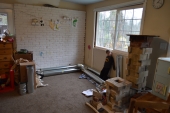One more quick update on Jerry.
I've rebuilt the heat riser twice due to the sheet metal ducting warping from the heat, so this last time I added a significant amount of clay to the perlite/clay mix as well as a small amount of peat moss (figured it'll burn off much like sawdust) and I packed it TIGHT. Total clay to perlite to peat moss was probably 5 parts clay slip to 10 parts perlite and maybe 2 parts peat moss. Lo and behold, it's holding up beautifully and Jerry runs stronger than before!
We have a significant problem with the ducting running through the bench where the ground subsided and caused a valley about 10 feet in - water collects there and we need to drain it every day or two. Late this summer, we're going to tear the bench apart and rebuild to hopefully correct this because it's become a major pain in the butt. We'll also likely be adding another 10 feet or so of ducting before the exit stack as there's quite a bit of heat in the exhaust at this point. I'm planning a 5-7 foot dead-end bench extension as well to hopefully keep the east wall of the hoophouse from icing up at night.
We've switched to burning about 80% larger split wood as the saplings are just too time consuming to prep in quantity at this point. I can split twice as much as I can clip up in saplings, so for this winter at least, I'm cutting and splitting logs. We're able to get away with full rounds up to about 4-5 inches in diameter without choking the air flow, but anything over 3 inches tends to cool the burn down a bit.
We've burned probably around 2-3 cords of wood so far since this fall, the majority of that during december and early january, and as we burn it's like the thing just gets more and more efficient. I can see burning maybe 4 cords total during a NORMAL winter with the way it was running but maybe only 2-3 cords with how it's running now. With more bench, another 55 gallon drum or two of water and some hay bales stacked strategically around the east and west walls of the hoophouse, we might get that under 2 total.
I really wish we could have built it right in the living room because running in and out for hours on end every night is pretty frustrating. We burn about 6-8 hours nightly and have generally kept the hoophouse/sunroom above freezing even during temps down to -15*F. With temps 0-10*F, we're averaging about 55-60* air temps and with low 20s outside, we can get it into the 70s some nights. Rain and snow really puts a damper on the draw I've noticed. The colder and dryer it is, the harder the draw becomes.
The bench is staying nice and warm day and night now, reaching some 140*F near the manifold on a regular basis and averaging in the 100* range over the rest. We moved the BSF bin up on the bench to keep them warm during the cold snaps - even had to put the red worm bin on the bench (way down near the exit stack) after three nights of -15 to -20 readings.
Currently, the woman of the house is complaining because the feed tube area is getting so hot after a few hours of burn that she's burned herself on the outside of the cob (knew I should have put more insulation around everything). Every time she puts a piece of split green birch in the feed tube, it bursts into flames instantly she says. I keep telling her that's a good thing!
The other night, we successfully baked a 14lb turkey on the barrel top with a makeshift foil dome covering it as an oven. Took about 4 hours



















 I think the best thing about this RMH thing is that I can harvest firewood for a year with horticultural shears, loppers and a hatchet - no toxic petroleum gack or noise pollution necessary!
I think the best thing about this RMH thing is that I can harvest firewood for a year with horticultural shears, loppers and a hatchet - no toxic petroleum gack or noise pollution necessary!




 I was getting pretty discouraged there for a while but things have definitely improved
I was getting pretty discouraged there for a while but things have definitely improved



















